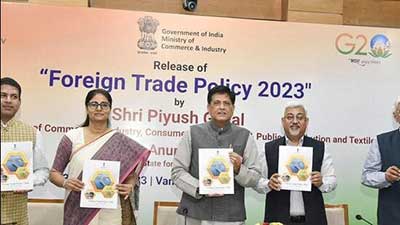Date: 04/04/2023
Relevance: GS-3: Indian Economy and issues relating to Planning, Mobilization of Resources, Growth, Development, and Employment.
Key Phrases: India’s Foreign Trade Policy, $2 trillion, paperless regulatory environment, Cross-Border Trade in the Digital Economy, Self-Declaration, One-Time Amnesty, Advance Authorisation, Export Promotion Capital Goods.
Why in News?
- India has unveiled its refreshed Foreign Trade Policy, which sets an ambitious target of reaching $2 trillion in total exports (goods and services combined) by 2030.
The Current State of India’s Trade
- Despite the pandemic and global trade disruptions, India's exports crossed the $760 billion mark in the fiscal year ending in March 2021, showing resilience and adaptability in the face of adversity.
- However, India's share in world merchandise exports remains relatively low at around 1.7%, indicating significant room for growth.
Strength of the policy:
- Focus on Reducing Transaction Costs and Time :
- The policy recognizes that reducing transaction costs and time is crucial to improving India's trade competitiveness
- This focus is essential as high transaction costs and lengthy procedures have long been a challenge for Indian exporters
- Promotion of Cross-Border Trade in the Digital Economy :
- The policy acknowledges the importance of the digital economy in driving future growth and offers measures to promote cross-border trade in this area
- The establishment of dedicated e-commerce export hubs is a positive step towards promoting the growth of the digital economy and boosting exports
- Shift to an Enabling Regime of Duty Remission and Exemption Schemes :
- The policy adapts to new realities by shifting from incentives to an enabling regime of duty remission and exemption schemes
- This shift is more in line with India's WTO obligations and is expected to facilitate duty-free imports of inputs required for boosting exports
- Emphasis on Self-Declaration and One-Time Amnesty :
- The policy offers the facility of self-declaration across the board to all exporters in the apparel and clothing sector
- This move is expected to reduce compliance costs and improve the ease of doing business for exporters in this sector
- Additionally, the policy offers a one-time amnesty, giving exporters more time to avail of both the AA (Advance Authorisation) and EPCG (Export Promotion Capital Goods) schemes
- Commitment to National Trade Facilitation Action Plan :
- The policy emphasizes the importance of the National Trade Facilitation Action Plan and its role in achieving trade facilitation goals
- The commitment to this plan is expected to improve the ease of doing business and reduce the time and cost of trade, thereby boosting exports.
Limitations of the policy:
- No clear roadmap:
- While the policy sets an ambitious target of $2 trillion in total exports by 2030, it does not offer a clear roadmap for achieving this goal.
- This lack of a well-defined plan could make it difficult for policymakers and businesses to align their strategies with the government's export goals.
- No detailed measures to support struggling sectors:
- Several sectors, such as the services sector, are currently facing headwinds and require targeted support to help them recover.
- The policy does not offer detailed measures to support these sectors, which could hinder their growth and impede progress toward the $2 trillion target.
- No introduction of new schemes for sector-specific growth:
- The policy offers some minor tweaks to existing duty remission and exemption schemes, but it does not introduce any new schemes that could drive growth in specific sectors.
- This lack of sectoral focus could limit the policy's effectiveness in boosting exports and supporting targeted industries.
- Limited support for small and medium-sized enterprises (SMEs):
- SMEs play a crucial role in India's export ecosystem, but the policy offers limited support for these businesses.
- This could make it difficult for SMEs to compete with larger firms and hinder their ability to participate in global trade.
Challenges Ahead:
- Navigating uncertain global trade:
- COVID-19 caused demand contraction & disrupted trade flows
- Geopolitical tensions (e.g., US-China trade war, Russia-Ukraine conflict) add to the uncertainty
- Shift towards protectionism & regional trade agreements pose new challenges for India's exporters.
- Addressing domestic constraints:
- Inadequate infrastructure, including ports, roads, and railways.
- Regulatory hurdles, such as complex customs procedures and cumbersome licensing requirements
- Skill shortages in certain sectors such as manufacturing
- Implementation and monitoring:
- Effective implementation and monitoring are crucial
- Efficient and transparent administration of duty remission and exemption schemes is essential.
- Regular reviews are necessary to ensure the policy remains relevant and responsive to changing trade dynamics.
Conclusion:
- India's Foreign Trade Policy sets an ambitious target of tripling the country's exports by 2030.
- While the policy outlines several broad goals and strategies, it needs to provide more targeted measures to achieve this target.
- India’s foreign trade policy is an important tool for driving the country’s economic growth, and policymakers must continue to fine-tune it to make it more effective and efficient.
Source: The Hindu
Mains Question:
Q. “India's new Foreign Trade Policy has set an ambitious target of reaching $2 trillion in total exports by 2030.” Analyse the policy's approach towards achieving this target and suggest measures to address the shortcomings in the policy.







